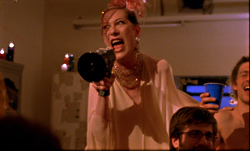If they held one of those 24-hour moviemaking projects for this year’s Seattle Lesbian & Gay Film Festival, the perfect insta-documentary would’ve been The Mark Foley Story, being a campaign year and all, which is when the dread specter of urban faggotry is traditionally used to rally the Republican base. But an IM-abusing chicken-hawk Florida congressman among their own kind? Wow, it almost makes a voter, you know, horny at the prospect of such electoral folly.
But in the real world, or the queer world (or perhaps the really queer world), the most revolutionary political document of the fall may be the SLGFF’s gala opener, Shortbus, a patriotic post-9/11 fantasia of (real) sex and human connection from John Cameron Mitchell (Hedwig and the Angry Inch). Of it, our L.A. Weekly colleague Scott Foundas recently wrote, “[T]he boldest provocation of Mitchell’s sweet, tender, and gently funny film may be its exuberant celebration of community and togetherness at a cultural moment rife with fatalism and disconnect.” There you have it—it takes a village, or a village sleeping with a village, or something like that. And after the screening (8 p.m. Fri., Oct. 13; Cinerama), you get to party with the octopi at the Seattle Aquarium. (Shortbus begins its commercial release Oct. 20, by which time you’ll surely want to lord it over your friends that you’ve already seen it.)
Ever the charmingly loquacious provocateur, Mitchell also turns up in two SLGFF docs: Follow My Voice: With the Music of Hedwig (2:30 p.m. Sun., Oct. 22; Cinerama), in which Rufus Wainwright, Sleater-Kinney, and others help record a Hedwig benefit album for LGBT youth; and Fabulous! The Story of Queer Cinema (4:30 p.m. Sat., Oct. 14; Harvard Exit). That talking-heads-and-clips survey proceeds on two parallel tracks of what might be called the gay text and the gay subtext: On the one hand, yes, we’ve come a long way from studying vintage Rock Hudson movies for limp-wristed clues of deviancy; on the other, mainstream acceptance (well, at least at Sundance and in the blue states) also plants a tombstone on the old scrutiny. (That, plus DVD and streaming.) Not having to look so hard at a film means not looking so closely at it—which is really the first and gayest rule of film criticism: Watch more intently for what others don’t see, regardless of the spectacle and swirl telling you what the film’s supposedly about. The old duality takes a practiced, if not ingrained, eye for double meanings. Says Mitchell, “You grow up not telling the truth. So you’re aware of artifice. So you’re aware of acting.”
I’m not sure what Mitchell would make of Dolly Parton, however, as unlikely fetish object in For the Love of Dolly (2:15 p.m. Sat., Oct. 24; Cinerama). The obsessive fans documented here are both gay and straight, but they’re united by a devoted, irony-free adulation that collapses our divided notions of Wal-Mart versus Queer Eye America. If two sexless heterosexual women and a dowdy gay Texas couple and even a developmentally disabled fellow can agree on Dolly as deity (as opposed to Liza or Barbra or Diana or Madonna), what are we to think of all those cultural wedge issues?
Gathering annually for the April opening of Tennessee’s Dollyland theme park—note to Madonna: Think of the rides and roller coasters that could be modeled on your career—these pilgrims seem to see in Dolly a kind of perfection missing in their own lives. You could say the same of Deadheads in their day, but these Dollyheads keep their icon (vessel?) at a curious distance. The gay Texans even go so far as to make porcelain Dolly dolls, adding to the ephemera and collectibles that have turned their home into a shrine to their idol.
Director Tai Uhlmann doesn’t mock these outcasts at all. All have hard-luck stories, some left rather vague, that place them in the tragic victim mold. You could call it a gay stereotype, of course, but For the Love of Dolly shows us how that category can extend beyond the bedroom and sexual preference. Mitchell would probably agree that it’s the common yearning, the urge for transcendence that’s “gay” in a way flyover America feels, too, but uses a different word to express. (Compassion, perhaps, or sympathy.) Emotionally, at some point in their lives, everybody—including poor Rep. Foley—knows what it’s like to be in the closet.
OR IN PRISON. The strongest doc at SLGFF is likely Songbirds, a British portrait of female inmates whose lives are startlingly and affectingly rendered in song (6 p.m. Wed., Oct. 18; Harvard Exit). Instead of the usual dull talking heads—though there’s some of that, too—Songbirds distills their sad stories into rap and pop ballads written by professionals (lyricist Simon Armitage and composer Simon Boswell). Their tales of abuse, drugs, and violence would be right at home on the radio—until you consider the lyrics more closely. “Don’t give her back her life, she wouldn’t know what to do. . . . She’s better off inside.” So raps Mary, a dyke and unhappy career criminal who claims to almost prefer the structure of prison life to the chaos outside. (Other inmates only become bisexual inside the walls of Downview Prison, she says in passing.)
There’s only one middle-class prisoner among the songbirds (and, strangely, she doesn’t sing), and director Brian Hill stretches out her story in a manner that distracts from the more representative women and their wonderful songs. But, like the two Americas invoked in John Edwards’ past (and future?) campaign, I suppose there are two Britains, too. That they should both meet in prison shouldn’t be any more surprising than gays and straights sharing the same Shortbus bed, or lining up at Dollywood, or attending the same film festival.








